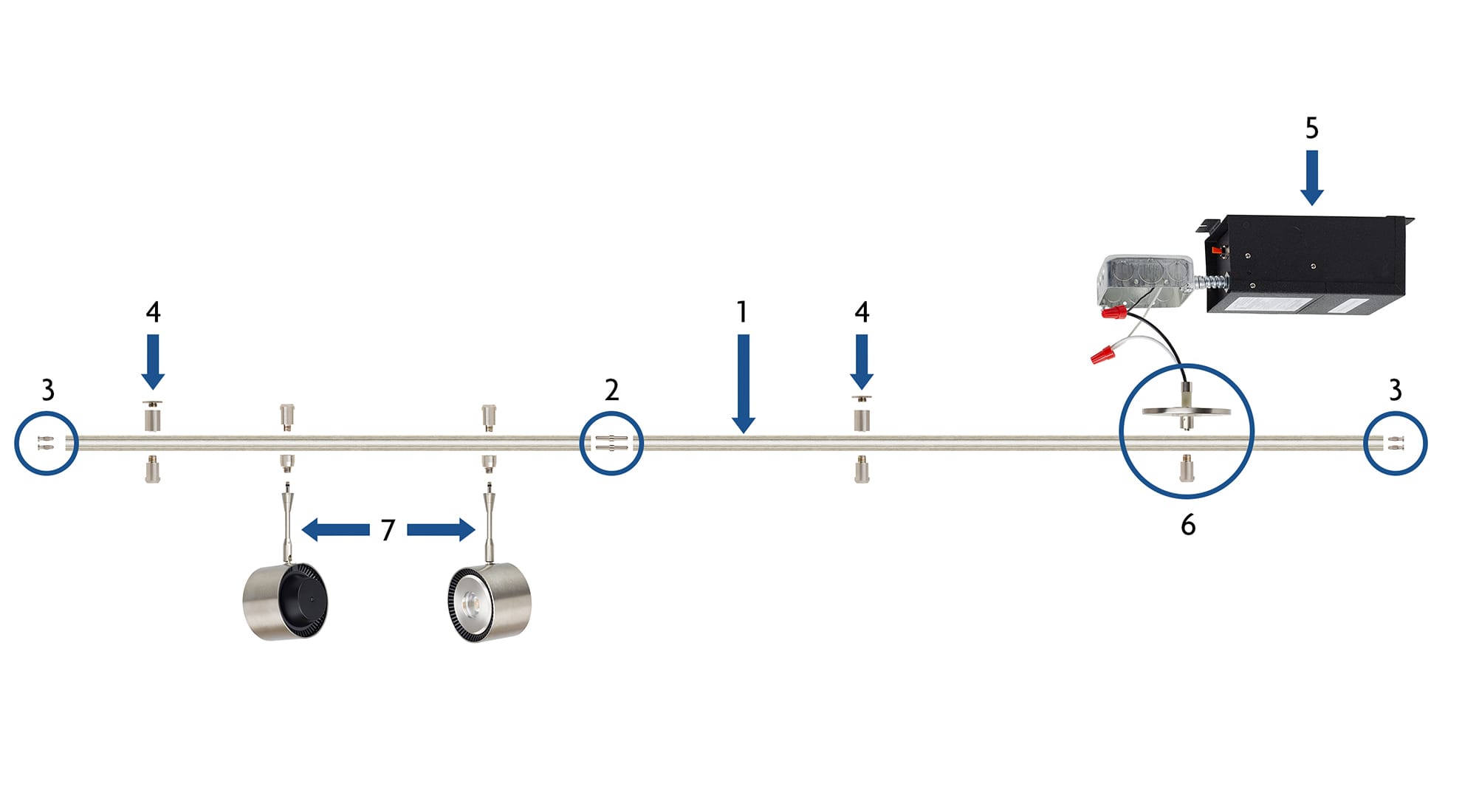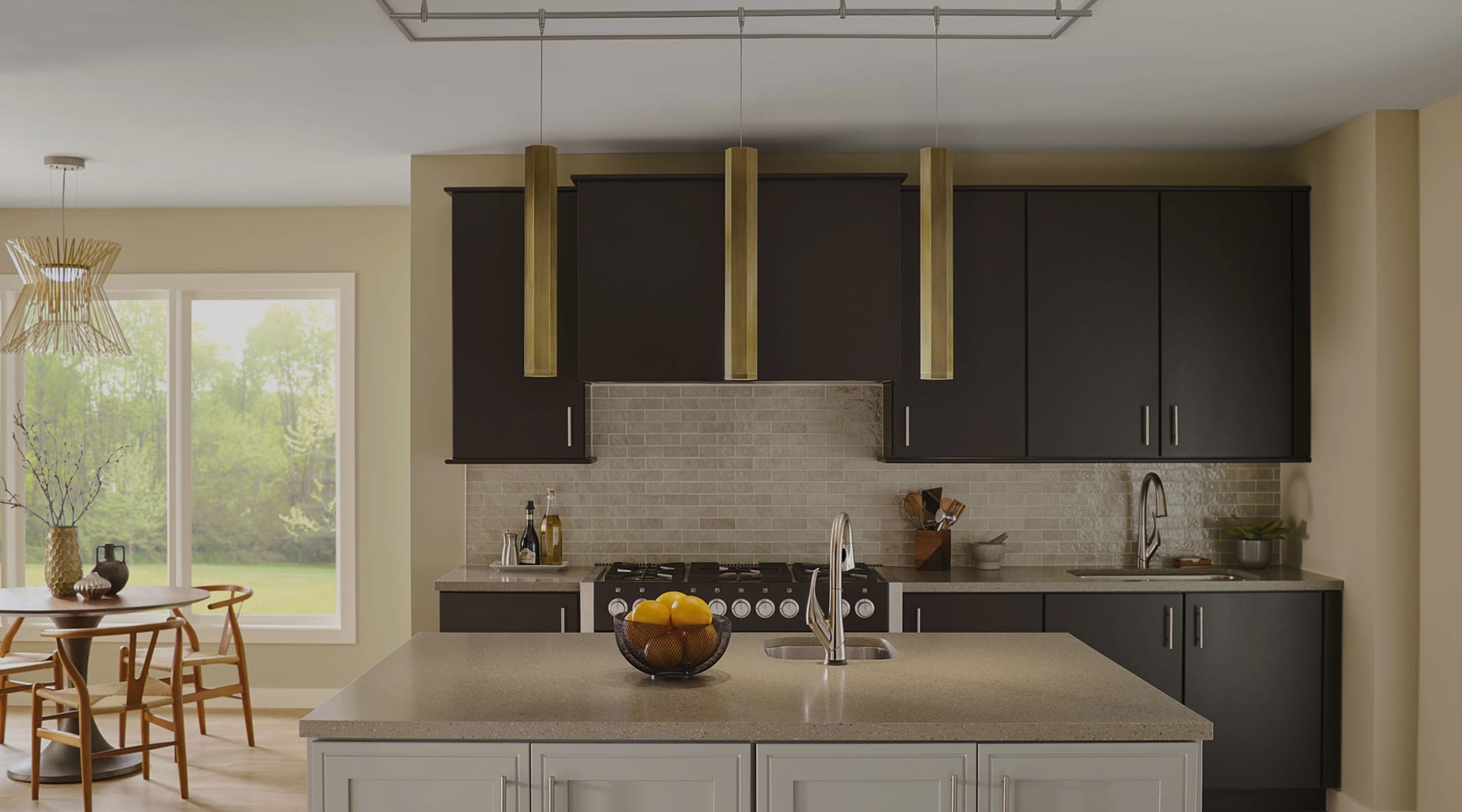Using Monorail to Solve Lighting Challenges
With simple installation, a minimalist look and a vast variety of decorative options
to choose from, monorail lighting is an elegant solution for a wide array of lighting needs.
One of our favorite design-centric solutions for what we know as track lighting is monorail: a slim, ribbon-shaped, low-voltage lighting system that is both elegant and functional for adding light to spaces with various lighting needs.
Better than normal 120-volt track lighting—which can be bulky because it has robust insulation—monorail has a minimal profile, a wide variety of choices in low-voltage pendants and spot or linear heads to install on the rail, and it meets today’s clean aesthetic to beautifully complement the architecture in any home or commercial space.
When Monorail Can Solve a Lighting Challenge
| Challenge | Solution |
|---|---|
| Lighting is needed in places where electrical isn’t available. | Monorail can be run from an existing junction box to various places in the room. |
| The ceiling is so high, lighting needs to be brought down to human scale. | With ceiling mount options, monorail can be suspended from the ceiling down to a comfortable height. |
| The ceiling is vaulted. | Monorail offers several vault adapter options. |
| A space’s function changes, and lighting fixtures need to be relocated. | Monorail allows for rearrangement of spot heads, linear heads and pendants along the system. It also allows future refresh from older monorail heads and pendants to new ones. |
| A space has an “S” shape or curved walls. | Monorail can be pre-bent or curved upon order. Post-order, it’s also hand-bendable and field-cuttable. |
| One space needs general, task and accent lighting, with one simple configuration. | Spot and linear heads can be rotated or pivoted to aim light where needed. |
| Artwork should be highlighted. | Monorail hosts a wide variety of spot heads, including those most appropriate to bring attention to artwork. |
| A remodeled space demands a remodeled light scheme. | Monorail can be installed with a single power source without the hassle of dealing with existing stud configuration or breaking into a ceiling. |
Here, the monorail is curved and has spot heads to light the varying work areas in the kitchen.
Questions to Ask Yourself First
How many lights—and what kind of heads and pendants—do you want to add to your system to achieve your lighting design? Think about the room’s function (or multiple functions) and whether there are any architectural features you want to emphasize. While monorail runs shouldn’t be longer than 30 feet either way from the power feed, runs can be lengthened with additional power feeds.
Will you need a remote or surface-mounted transformer? If this is new construction, choose a remote transformer that can be hidden in a nearby, accessible space such as a cabinet or closet. For existing construction, choose a surface mount transformer; it will be visible as part of the monorail configuration, but there are many unobtrusive and sleek models out there.
Other considerations may include what are your preferred finishes and décor style; will the lighting system be a straight run, curved run or will it turn at a specific location along the rail; or how far down from the ceiling do you want to suspend the rail?
The owner of this kitchen used the Monorail lighting system to hang spot heads to provide task lighting for the prep area and pendants to provide general illumination.
The Anatomy of a Monorail System
All monorail’s power, standoff and fixture connections are shaped identically for design harmony. It’s rated for 300 watts at 12 volts and 600 watts at 24 volts. Each piece of rail is shipped with conductive connectors to join rail pieces end to end. To better understand how this lighting system works all together, below is a chart:

- The rail, which is the core of the Monorail lighting system
- Connectors for using multiple rail lengths (adjustable connectors are available for making turns)
- End caps to finish each end of the complete Monorail run
- Standoffs (adjustable or rigid) to support the rail and light fixtures
- Transformer (remote or surface mount) to convert line-voltage (120 volts) to safe, low-voltage electricity
- Power feed canopy (not required with surface mount transformers)
- Low-voltage spot heads (you can add linear heads and/or pendants as well)
In this home office, Lev linear heads are along the ModernRail lighting system to provide general illumination and accent lighting.
Two-Circuit Monorail
Two-circuit monorail lighting offers even more flexibility. For example, if you want to place all pendants and spot heads on one rail, you can control them independently. This is perfect for the kitchen or any other space if you want to create different moods or provide light for varying functions. With any monorail system, consider getting a dimmer switch.
Monorail Kits
If what you want to light is fairly simple and you like the look of monorail, this lighting system is also available in kits. They come with every component needed—all you have to do is choose the low-voltage heads and/or pendants along with the kit’s transformer.
If you need more assistance with choosing your monorail lighting, call our lighting experts at 877.445.4486.







